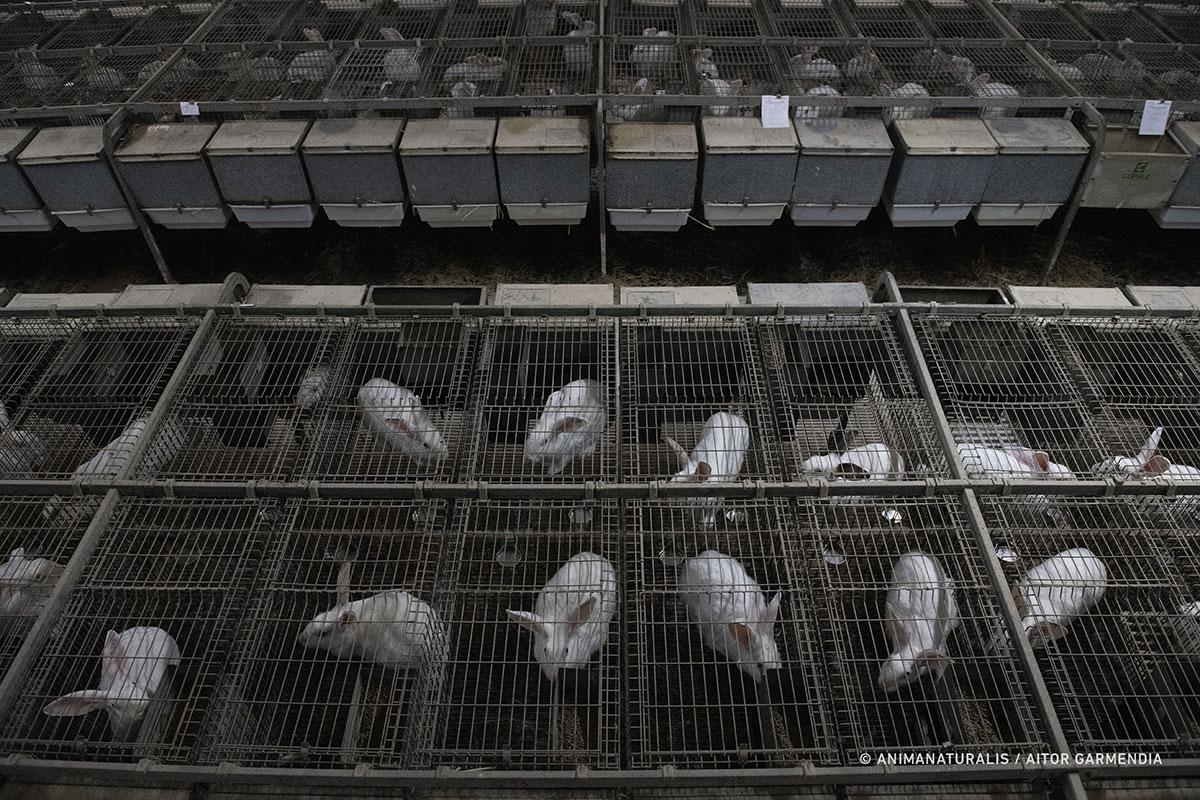Status of rabbit factory farms in Spain
In Spain, there are currently 1,412 fattening rabbit farms in operation. In 2022 alone, 33.3 million of these animals were slaughtered for their meat in slaughterhouses. According to an estimate by the European Food Safety Authority (EFSA), which reports a 20% mortality rate in rabbit farms, approximately 41.25 million rabbits would have been born that year. In other words, one-fifth of the rabbits raised in the country ended up in garbage containers.
Rabbit meat production in the European Union is primarily concentrated in the Mediterranean area. Spain remains the leader, accounting for around 70% of the entire rabbit industry along with Italy and France. Despite these figures, rabbit meat represents only 3% of all meat consumed in the European Union.

In Spain, per capita consumption has decreased by 50% since 2018 and currently stands at 750 grams annually, still above the European average of 570 grams. Despite this relatively low consumption, in terms of the number of individuals, rabbits are the second most raised and slaughtered animals for human consumption, with 180 million rabbits raised for their meat each year in the EU.
AnimaNaturalis has gathered evidence of the poor conditions in which rabbits are raised, fattened, and disposed of in Spain. Their research team has documented deplorable conditions throughout the production cycle - maternity, breeding, and fattening - in 10 Spanish farms in some of the Autonomous Communities with the highest rabbit concentrations in the country, such as Castilla y León (1,465,886), Catalonia (879,977), Aragón (467,063), and Castilla-La Mancha (292,576).

Images obtained by AnimaNaturalis from several farms during the winter of 2023 depict live rabbits coexisting with corpses; animals piled up in cages turned into mass graves; rabbits on the ground, devoured by cats, entire litters of crushed youngsters, and others dying on the cage bars; facilities covered in cobwebs, hair, and dirt, or with pits overflowing with slurry, flooding the corridors.
Rabbits have also been found outside the cages, condemned to die of hunger and thirst, lifeless goats among the excrement; animals with untreated eye, ear, and skin diseases, deformed paws, abortions, tumors, rabbits pulling out each other's fur due to stress and nutritional deficiencies, and garbage bins full of carcasses in each facility.

Rabbits are very sensitive animals and particularly vulnerable in the livestock industry because they lack specific regulations that protect their well-being. However, their situation could soon change if the European Commission fulfills its promise to review the animal welfare regulatory framework for Europe in the coming months.
The European Food Safety Authority already reported in 2020 that Spanish farms use the worst possible production system in terms of animal welfare, and that 20% of rabbits die before reaching the slaughterhouses.

In addition to the use of traditional cages, EFSA experts highlighted in their 2020 complaint a series of additional consequences for the animal welfare of the Spanish breeding system. They pointed out "rest problems, prolonged thirst or hunger, heat stress, and skin disorders."
In addition to new European regulations that could be developed in 2024, there is a commitment to gradually eliminate cages for all animals on farms before 2027, promoted by the European Citizens' Initiative End The Cage Age. This initiative was supported by 1.4 million citizens who demand better conditions for more than 300 million European pigs, calves, chickens, rabbits, and others.

While several producing states have implemented some improvements in rabbit welfare in recent years, the Spanish Ministry of Agriculture, Fisheries, and Livestock shows no intention of transitioning to a cage-free system unless pressure is exerted from the EU, accompanied by deadlines, aid, and other benefits to adapt to the new system.
Some countries that partially protect rabbit welfare on their farms include Austria, where battery cages were banned in 2012; Belgium, which began phasing them out in 2016 with the goal of eliminating them by 2025; and others with specific requirements for breeding and handling, such as the United Kingdom, Switzerland, Germany, or the Netherlands.
